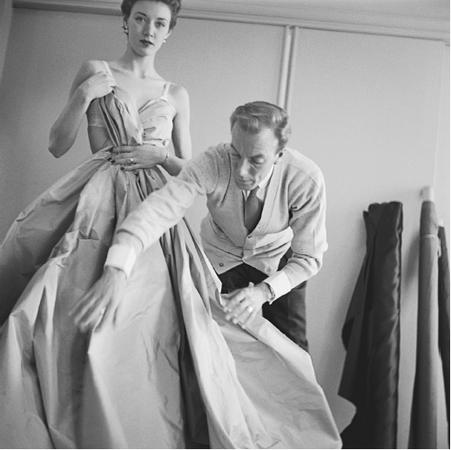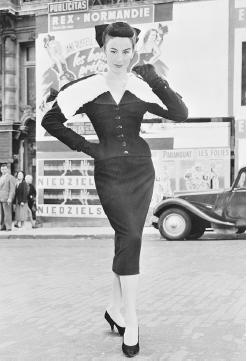Jacques Fath - Fashion Designer Encyclopedia
French designer
Born: Lafitte, France, 12 September 1912. Education: Studied bookkeeping and law, Commercial Institute, Vincennes, France. Family: Married Geneviéve Boucher de la Bruyére, 1939; son: Philippe. Military Service: Completed required military service and served again in the artillery during World War II. Career: Book-keeper, then trader at the Paris Bourse, 1930-32; showed first collection, Paris, 1937; reopened salon, 1940; designed ready-to-wear collection for American manufacturer Joseph Halpert, 1948; formed own company in the U.S., 1951; developed ready-to-wear collection in Paris, 1954, including Fath scarves and hosiery; business sold, 1957; fragrance license bought back from L'Oreal, 1992; Tom Van Lingen hired as designer, 1992; relaunched several fragrances, from 1993; company bought by Groupe Emanuelle Khanh, 1997; Elena Nazarhoff replaced Van Lingen as artistic director, 1997; Nazarhoff fired and Octavio Pizarro hired, 1998; fragrances include: Green Water, reissued 1993; Fath de Fath, 1957 and 1995; Yin and Yang, 2000. Exhibitions: Jacques Fath Création-Couture des Années 50 (retrospective), Palais Galleria, Paris, 1993. Awards: Neiman Marcus award, Dallas, 1949. Died: 13 November 1954, in Paris.
Publications
On FATH:
Books
Bertin, Célia, Paris á la Mode, London, 1956.
Ballard, Bettina, In My Fashion, New York, 1960.
Oster, André, "Jacques Fath Recalled," in Ruth Lynam, ed., Couture: An Illustrated History of the Great Paris Designers and Their Creations, New York, 1972.
Milbank, Caroline Rennolds, Couture: The Great Designers, New York, 1985.
Veillon, Dominique, La mode sous l'occupation, Paris, 1990.
Guillaume, Valérie, Jacques Fath (exhibition catalogue), Paris, 1993.
Stegemeyer, Anne, Who's Who in Fashion, Third Edition, New York,1996.

Articles
Coughlan, Robert, "Designer for Americans: Jacques Fath of Paris Sells U.S. Women Wearable Glamour," in Life Magazine (New York), October 1949.
"Jacques Fath," in Current Biography (New York), April 1951.
Roberts, Eleanor, "Fath Brings Paris Chi-Chi to Boston," in the Boston Post, 18 December 1953.
Obituary, in the New York Times, 14 November 1954.
"Page After Page of the Good and the Controversial in the World of Fashion," in the Chicago Tribune, 11 December 1991.
Deeny, Godfrey, "A Revival of the House that Jacques Built," in WWD, 26 February 1992.
Stern, Suzanne Pierrette, "Memories of a Parisian Seamstress: Tales and Techniques from the Workrooms of Couturier Jacques Fath," in Threads (Newtown, Connecticut), April/May 1992.
Milbank, Caroline Rennolds, "Jacques Fath: The Mercurial Host at Corbeville and Paris," in Architectural Digest, October 1994.

Weisman, Katherine, "The Renewal of Jacques Fath," in WWD, 25May 1995.
Larson, Soren, "Giving the Jacques Fath Fragrances a New Life," in WWD, 8 September 1995.
"Khanh Acquires House of Fath," in WWD, 17 March 1997.
Wilson, Eric, "Fath Dismisses RTW Designer Elena Nazar," in WWD, 24 November 1997.
"Opposites Attract," in Soap Perfumery & Cosmetics, January 2000.
***
Jacques Fath had a short career—from 1937 until his death in 1954—and after he died his name fell into obscurity. In contrast to his great contemporaries, Christian Dior and Cristobal Balenciaga, Fath has been largely forgotten, but he deserves to be rediscovered as a talented creator.
Fath was born in 1912 into a Protestant family of Flemish and Alsatian origin. His great-grandmother had been a dressmaker to the empress Eugéne and, from an early age, he showed an interest in designing clothes. He also toyed with the idea of becoming an actor, a craving he later indulged in private theatricals and costume parties.
Fath had "the showy elegance of a character from a Cocteau play and the charm of an enfant terrible, " recalled Célia Bertin in Paris á la Mode, in London, in 1956. But fashion editors like Bettina Ballard and Carmel Snow (of Harper's Bazaar ) tended to dismiss Fath as "a good-looking child prodigy…with slightly theatrical fashion ideas not worthy of the hallowed pages of Vogue or Harper's Bazaar ."
Fath's career was interrupted by the outbreak of World War II. Taken prisoner in 1940, he was, however, soon back in Paris, where he reopened his couture house with his wife Geneviéve. A book on fashion during the Nazi Occupation noted that scruples of conscience did not embarrass Fath, who was closely associated with various Franco-German groups and whose clientéle consisted heavily of Germans, wealthy collaborators, and black marketeers. Unlike Chanel, however, whose reputation as a Nazi sympathizer temporarily injured her postwar career, Fath's image emerged intact, and after the war, his international career took off.
His glove-fitted dresses glorified the female form, and some have said Fath even inspired Dior's New Look. Certainly, Fath designed some of the sexiest and most glamorous dresses to come out of Paris. The typical Fath dress featured a fitted bodice that molded a slender waistline and emphasized the swelling curves of bosom and hips. Sleeve and collar treatments were important to Fath, and he favored irregular necklines that drew attention to the breasts. Skirts were either very slim or very full, characterized perhaps by a whirlpool of pleats or interesting draped effects.
If Dior and Balenciaga were known for the architectural beauty of their designs, Fath's style was praised for its glamor and vivacity. He often used diagonal lines, asymmetrical drapery, and floating panels to give a sense of movement. Nor was he afraid of color, even using such daring combinations as bright blue and green. (He himself liked to wear a red tartan jacket.) Whereas Dior's career was characterized by striking shifts of silhouette (the A-line, the H-line, etc.), Fath maintained an unswerving fidelity to the female form divine, focusing on sexy lines and novel decorative details, such as rows of nonfunctional buttons. Fath's style of wearable glamor had a wide appeal, and in 1948 he signed an agreement with the American manufacturer, Joseph Halpert. Henceforth, in addition to his own couture collections, Fath produced a low-priced American line as well.
Fath was increasingly regarded as the "heir apparent to Dior's throne." As Life Magazine said in 1949: "Dior is still generally acknowledged to be the head man, so to speak, of the fashion world, but Fath has recently had a spectacular rise in prestige, and it now seems likely that the next look to confront and impoverish the U.S. male will be the Fath look." Carmel Snow, editor of Harper's Bazaar, revised her earlier opinion of Fath, declaring, "He makes you look like you have sex appeal—and believe me, that's important."
Fath himself had tremendous personal appeal, with his blond wavy hair and slender physique (a 28-inch waist, claimed one source). He was also very much a social personality; he and his pretty wife loved throwing lavish and imaginative parties, which had the pleasant side-effect of providing excellent publicity. "An atmosphere of glitter, chic, and perfumed excitement permeates both his personal and business affairs," observed Life magazine in October 1949. Yet behind the scenes, Fath was struggling with illness. Only a year before his death in 1954, the American press had hailed him as the "fabulous young French designer who…is out to make every woman look like a great beauty." This promise was tragically cut short; Fath died of leukemia at the age of 42.
Though the Fath house languished for some time, the firm was revived by new designer Tom Van Lingen, who came aboard in 1992, and the relaunch of several of the firm's early fragrances. In 1997, Groupe Emanuelle Khanh and its subsidiary, Jean-Louis Scherrer, bought the fashion house and installed Elena Nazaroff as its ready-to-wear designer, replacing Van Lingen. Yet Nazaroff was fired after one season and Fath hired Octavio Pizarro, who had designed his own label in Chile before working at Jean-Louis Scherrer with Bernard Perris. Two new complementary fragrances, his-and-hers fragrances, Yin and Yang were released in 2000.
—ValerieSteele
Comment about this article, ask questions, or add new information about this topic: